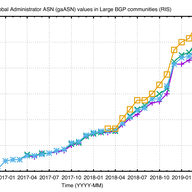
BGP Large Communities Uptake - An Update
• 4 min read
We were asked by the community to look at the uptake of BGP Large Communities as observed by our Routing Information Service (RIS).

Based in Amsterdam, NL
Articles
Likes on articles
I'm a data scientist at the RIPE NCC. I'm a chemist by training, but have been working since 1998 on Internet related things, as a sysadmin, security consultant, web developer and researcher. I am interested in technology changes (like IPv6 deployment), Internet measurement, data analysis, data visualisation, sustainability and security. I'd like to bring research and operations closer together, ie. do research that is operationally relevant. When I'm not working I like to make music (electric guitar, bass and drums), do sports (swimming, (inline) skating, bouldering, soccer), and try to be a good parent.
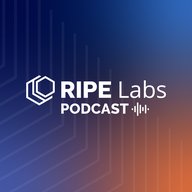
• 2 min read
When two Internet cables in the Baltic Sea were reported as broken last November, we turned to RIPE Atlas to examine the damage. In this episode, Emile Aben discusses what his analysis uncovered about the impact of these and similar incidents, and how the Internet remained resilient.
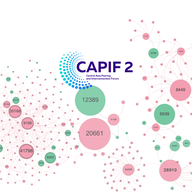
• 11 min read
From 19-20 September, network operators, local IXPs, peering coordinators, Internet researchers and government officials will meet at CAPIF 2 to build a more diverse interconnection environment in Central Asia, Iran, and beyond. To prepare, we’ve been examining changes in local interconnection and …
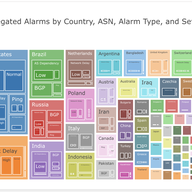
• 6 min read
In this article, Mohamed presents his Google Summer of Code project that correlates and aggregates alarm data to detect real-world Internet outages. His project integrates data from IHR, GRIP, and IODA, visualising BGP hijacking, delays, and outages for improved real-time monitoring.

• 6 min read
In November 2021, Internet users from Mexico lost access to whatsapp.net and facebook.com. By the time the event was reported, the underlying problem had already gone unnoticed for quite some time. Here, we present key takeaways from our analysis of the event - carried out with RIPE Atlas - and we …
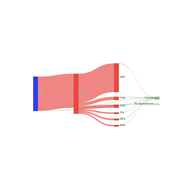
• 11 min read
This article presents a set of open-source tools - “reusable visualisations” - that extend the AS hegemony visualisations provided by the Internet Health Report. Users can directly use the online tools or embed the IHR data on their own posts, webpages, or Observable HQ notebooks.

• 11 min read
In this article we use data from RIPE Atlas probes to investigate the usage of 240/4, a block of IPv4 addresses 'reserved for future use', formally known as Class E in the wild.

• 6 min read
The events season has started! This article is an invitation to people from across many communities, whatever your role or level of experience, to come and participate in workshops, conferences, camps, lectures, festivals, and more.

• 11 min read
In 2021, reports emerged that hosts in Mexico were unable to reach whatsapp.net. It was determined that middleboxes were to blame, intercepting the queries to the root instance hosted in China and sending a bogus reply. This article investigates the prevalence of middleboxes using RIPE Atlas probes.
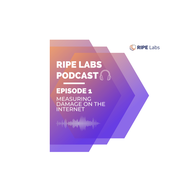
• 2 min read
In the first episode of the RIPE Labs podcast, Emile Aben shares his views on the importance of efforts to keep the Internet 'lit' by turning data from such sources as RIPE Atlas and RIPE RIS into visualisations that can help network operators understand what's going on when parts of the Internet g…
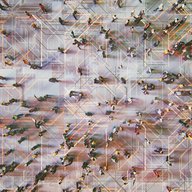
• 8 min read
The RIPE NCC recently held two Open House events to bring together people who help organise NOGs, which bring together people who help operate the Internet in particular parts the world.
“Thank you for this, Emil and Alun! From looking at the map you provided, it would be great to see an additional anchor in Katthammarsvik. Do you think it's worth trying to add one there?”
Thanks for the suggestion. I think that depends on the physical (cables) and logical (routing) topology near Katthammarsvik in relation to the cable landing there. In a quick search I didn't find datacentres there, which makes me think it would not be too useful. Experts on the local Internet infrastructure would probably be able to answer if it would make sense or not.
This RIPE Labs article has good information on how to avoid effects from unknown attributes showing up at your BGP routers: https://labs.ripe.net/author/berislav_todorovic/bgp-path-attribute-filtering-a-powerful-tool-to-mitigate-alien-attributes/
“Hi Emile, I remember attribute 28 showing up in several previous studies. Interesting to see it causing a problem this time! As bgpdump maintainer, I'd ask you to check out v1.6.2 or higher, since 2020 there is a '-u' flag to output unknown attributes in the short (-m) mode (helpfully submitted by Italo Cunha) - it may make your future parsing life much easier :) Kind regards, Colin”
Thanks Colin, I didn't know, and this would have speeded up my analysis if I had!
Code for looking into AS Adjacency changes is available here: https://github.com/emileaben/as-neighbour-diff
Code on how to create graphs like Figure 1 ( ie. BGP view of how networks in a country interconnect ) is available here: https://github.com/InternetHealthReport/country-as-hegemony-viz
NOG Alliance is helping out network operators in Ukraine: https://nogalliance.org/our-task-forces/keep-ukraine-connected/
An effort related to keeping Urkanian servers/websites online by the Dutch Cloud Community: https://dutchcloudcommunity.nl/community/cloud4ukraine/
We got a request for the HHI scores for other countries. I've put these in a small repo on github together with the code that generated this. repo: https://github.com/emileaben/hhi-eyeballs HHI scores for 2022-03-07 are available here: https://raw.githubusercontent.com/emileaben/hhi-eyeballs/main/eyeball-hhi.2022-03-07.csv
“This is awesome work, thank you! Do you maybe have the script/notebooks/sources to reproduce this? This could be potential used for other countries.”
Hi Jenneth, The observable notebook we used for this is here: https://observablehq.com/@aguformoso/internet-outages-as-seen-by-ripe-atlas . It's a little rough around the edges, so it would be great if you could help improve it!
Thanks for your comment Maxime. I would love to see more analysis too, and the tool allows people to do this. Take for instance this thread on Twitter where Jason Livingood analyses the signals for the US: https://twitter.com/jlivingood/status/1245142990336688130 If others have analysis for specific countries they want to share it would be great to have them collected, for instance as comments to this RIPE Labs post!
Showing 18 comment(s)